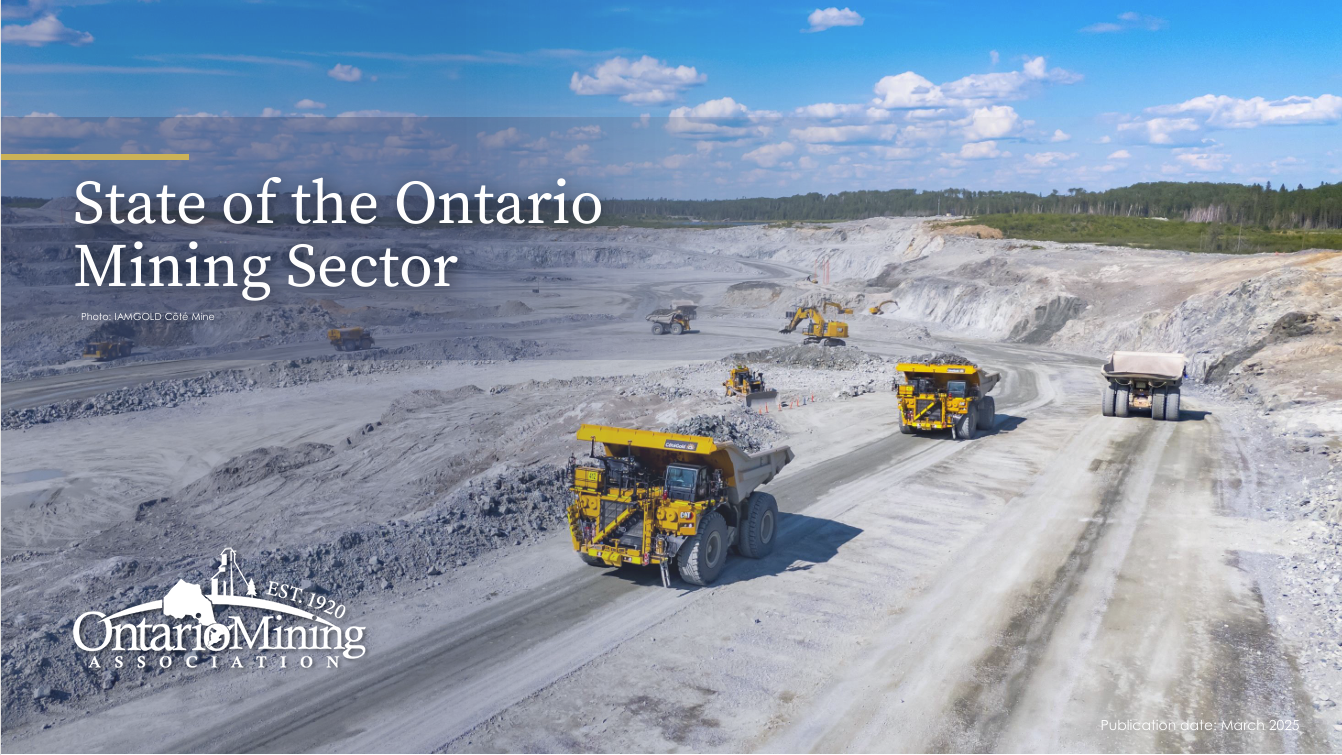Economic Contribution
Mining has been the backbone of Ontario’s economy for generations—driving innovation, creating well-paying jobs, and strengthening our supply chains. The State of the Ontario Mining Sector report, published in March 2025 with support from Ontario's Ministry of Mines, leverages the most recent data available to highlight the mining industry’s strategic role in the provincial economy and feeding global markets.
KEY FACTS
- Ontario is home to 36 active mining operations, extracting a diverse range of resources, including gold, base metals, iron, platinum group metals, and industrial minerals. In 2023, these operations generated a total value of $15.7 billion. Ontario remains Canada’s top gold producer, where 18 gold mines generated $6.5 billion. Nine active critical mines and 10 processing facilities generated $6.4 billion.
- The mining industry is a critical economic driver in Ontario, contributing $23.8 billion to the province’s GDP in 2023—nearly 3% of the total. With capital expenditures reaching $5.22 billion, the sector plays a key role in the northern economies, driving employment and fostering regional development. Between 2019 and 2024, five new mines opened in Northern Ontario, with six new mine projects and four mine expansions currently underway.
- The mining industry is crucial to the global supply chain, providing essential minerals used in technology and manufacturing. In 2023, mining accounted for over 25% of Ontario’s total domestic exports, with $64 billion worth of minerals and metals shipped abroad—$42 billion of which went to the United States, including $5.7 billion in critical minerals. 57% of all Ontario’s critical mineral exports went to the US. This strong trade performance highlights the mining sector’s pivotal role in North American manufacturing and continental security.
- The Ontario mining industry accounts for 23% of Canada’s total exploration spend, investing nearly $1 billion in exploration in 2023. Continued exploration and development are essential for maintaining future mineral reserves and sustaining long-term growth, especially in high-potential areas such as the Ring of Fire. There are also 12 advanced gold exploration projects in the province.
- The sector drives both employment and prosperity across Ontario, directly employing about 22,000 people with an average annual salary of $150,000—almost double the provincial all-industry average. Mining indirectly supports an additional 130,000 high-paying jobs.
- Indigenous representation in the mining workforce stands at 12% in 2023-2024, significantly higher than the 3% across Ontario’s overall workforce. This reflects the industry's commitment to inclusivity and engagement.
- The mining industry engages in 142 active agreements with Indigenous communities, fostering shared economic value and supporting community development. These agreements include exploration and impact benefit arrangements, as well as government resource revenue sharing. Notably, 35 First Nation communities receive 40% of annual mining taxes and royalties from operational mines, and 45% from future mines.
- The mining industry is committed to safety and employee well-being, maintaining a lost-time injury rate 17% lower than the all-industry average in Ontario since 2020. A low rate is a key indicator that safety protocols and practices are being followed effectively.
- Workforce shortages remain a challenge, with 21% of mining workers in Ontario over the age of 55. Initiatives like the OMA’s "This is Mine Life" campaign, encouraging young people to consider a career in mining, are having a positive impact. According to an omnibus poll of Ontario youth (aged 16 – 28) conducted by Ipsos in February 2025, approximately 1.3 million Ontario youth would now consider a career in mining, including 91,000 youth who reside in Northern Ontario.
- The sector is a leader in innovation and sustainability, adopting clean technologies at a pace well beyond the industry norm. This includes pioneering the industrial use of autonomous trucks and deploying battery-electric vehicles. Not only is the industry adopting clean technologies, but the minerals produced are essential to power low-carbon technologies and green energy sources.
Looking ahead, Ontario’s mining sector is poised for continued growth and global competitiveness. By leveraging its rich mineral resources, embracing innovation, and strengthening community and Indigenous partnerships, Ontario will remain a global leader in responsible mining. The sector’s contributions to GDP, trade, and technological advancement underscore its pivotal role in shaping Ontario’s economic future.
For more details, read the full report.
The OMA's Critical Mineral Analysis report, published in 2022, outlines several competitive advantages of Ontario’s mining sector, including strong mineral endowment and exploration potential. With demand for critical minerals surging, the province can leverage its endowment to become one of the leading global suppliers of certain critical materials to other jurisdictions whose advanced manufacturing sectors are reliant on imports.
The policy and business climate in Ontario makes the province one of the few responsible and politically stable critical minerals suppliers. Ontario’s critical mineral production and exploration pipeline is expected to support the development of renewable and advanced manufacturing technologies, providing opportunities for mining companies operating in Ontario to sell their products to growing global markets, including the US and the EU. It will also supply local needs from downstream industries and contribute to the growing domestic advanced manufacturing clusters, including automotive and mobility, as well as aerospace and defence.
| Read previous studies on the economic impact of Mining in Ontario |
|





